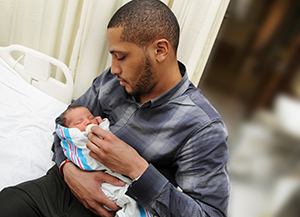Bottle feeding tips
Bottle feeding tips and terminology:
- When you bottle feed your baby, you should be seated comfortably.
- Hold the bottle so that the neck of the bottle and the nipple are always filled with formula. This helps your baby get formula instead of sucking and swallowing air. Air in the stomach may give baby a false sense of being full and may also cause discomfort.
- A slight outward tension on the nipple will prevent baby from gagging.
- Never prop up the bottle or leave baby alone to feed. The bottle can easily slip into the wrong position.
- Remember that baby needs the security and pleasure of being held at feeding time. It's a time to relax and enjoy each other.
- Baby should never take a bottle to bed. Bed bottles cause ear infections and tooth decay.
- Many formula varieties are on the market today. Each formula comes in many forms of preparation including powder, liquid that must be diluted and individually prepared bottles that only need to be opened, the nipple screwed into place and the baby fed.

Formula terms
The following is a brief explanation of some of the terms used on formula cans so you'll know what you're buying and how it should be prepared. It's also important to compare costs when you're buying the convenient forms of formula. They may save you a few moments in preparation time, but the increased cost may not be worth it.
Concentrate
- This means that the formula in the can is in concentrated form and must be diluted with water according to the instructions to create a formula that has the proper number of calories per ounce for the baby.
- Always follow the instructions carefully. If you don't, the formula will be too strong or too weak for the baby.
Ready-to-feed
- The formula in this can is already diluted and sterilized and needs no further preparation other than cleaning off the top of the can before opening it and pouring it into a clean bottle. It's now ready to feed the baby.
- Never dilute this formula. If you do, the baby will receive a greatly reduced number of calories per ounce.
Nursettes or ready-to-feed bottles
- These four- to six- to eight-ounce bottles are already mixed, sterilized and processed; all you do is remove the lid and screw on the nipple. The bottle is ready to feed to the baby in a few seconds from the cupboard shelf.
- These can be used only once; any remaining formula must be discarded, as with any bottle of formula. The cost varies but is roughly three times the cost of the concentrated liquid. And you may waste formula.
Powdered formula
- Like the concentrate, the powdered formula must be mixed with water before use. It dissolves easily when mixed with water.
- It stores on the shelf and can be used a scoop at a time. The cost of powdered formula is a little less than the concentrated liquid per ounce and is available in a one-pound can.
- Please note: The instructions for mixing powder and liquid are very different. Be sure to follow the proper instructions.
- Occasionally, baby does not tolerate the first formula selected.
- Please call your pediatrician before switching formula to help you make an informed decision.
- Remember, all babies spit up the first few days. Do not interpret normal spitting up as a formula intolerance.
- The amount of formula your baby takes will vary from one bottle to another.